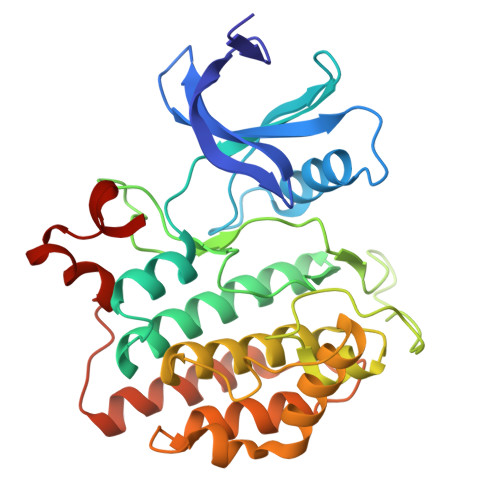Structure-guided optimization of small molecules targeting Yck2 as a strategy to combat Candida albicans.
Puumala, E., Nandakumar, M., Yiu, B., Stogios, P.J., Strickland, B.G., Zarnowski, R., Wang, X., Williams, N.S., Savchenko, A., Andes, D.R., Robbins, N., Whitesell, L., Willson, T.M., Cowen, L.E.(2025) Nat Commun 16: 2156-2156
- PubMed: 40038303
- DOI: https://doi.org/10.1038/s41467-025-57346-z
- Primary Citation of Related Structures:
9EDV, 9EDW, 9EDX, 9EDY - PubMed Abstract:
Candida albicans is the most common cause of life-threatening fungal infection in the developed world but remains a therapeutic challenge. Protein kinases have been rewarding drug targets across diverse indications but remain untapped for antifungal development. Previously, screening kinase inhibitors against C. albicans revealed a 2,3-aryl-pyrazolopyridine, GW461484A (GW), which targets casein kinase 1 (CK1) family member Yck2. Here, we report optimization of GW via two complementary approaches, synthesis of bioisosteres possessing an imidazo[1,2-a]pyridine core, and R-group substitution of GW's pyrazolo[1,5-a]pyridine core. Characterization of compounds reveals two 6-cyano derivatives with improved pharmacological properties that retain whole-cell bioactivity and selectivity for fungal Yck2 compared to human CK1α. Efficacy studies in mice indicate both analogs possess single-agent activity against C. albicans resistant to first-line echinocandin antifungals and potentiate non-curative echinocandin treatment. Results validate Yck2 as an antifungal target and encourage further development of inhibitors acting by this previously unexploited mode of action.
- Department of Molecular Genetics, University of Toronto, Toronto, ON, Canada.
Organizational Affiliation:


















